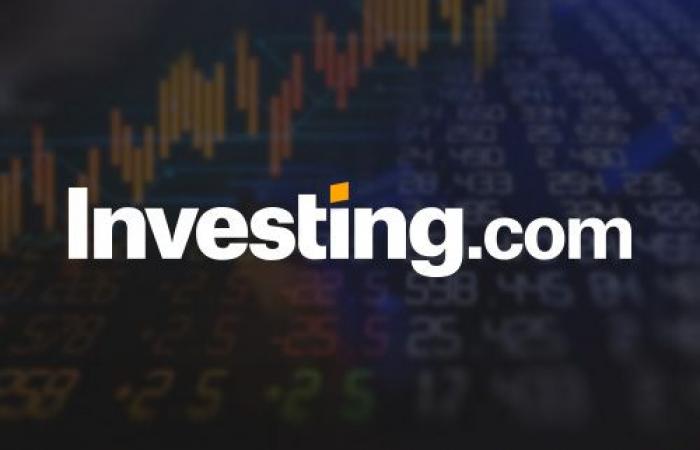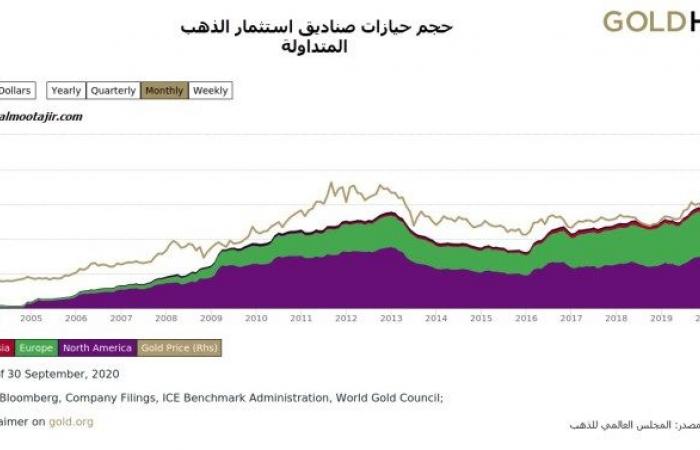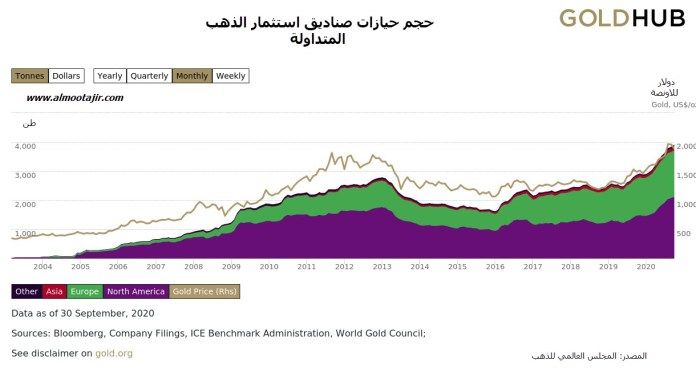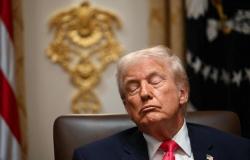In September, gold recorded a 4.2% decline in the COMEX futures exchange, its worst monthly performance in four years, and precisely since the presidential election in November 2016, when it fell by more than 7.79%. Nevertheless, investor demand for gold bullion has not decreased, but on the contrary, according to the latest report from the World Gold Council (WGC).
And it was reported about gold-backed ETFs that holdings of these funds rose for the tenth consecutive month, after recording positive inflows in September, which is the third time that this consecutive rise has occurred throughout this period (i.e. 10 months). After the years 2008 and 2016.
Gold ETF holdings rose 68.1 tons (4.6 billion USD) or 2.0% of AUM despite recording their worst monthly performance since November 2016.
Net positive flows in ETFs reached about 1003 tons of gold (55.7 billion US dollars) in a year, leading the global push for investors to demand for gold in 2020. The holdings of investment funds traded on the gold exchange rose to their highest levels ever at 3880 tons or $ 235 billion worth of assets under management at gold prices at the time of writing.
(To learn more about ETFs, you can check out this tutorial: What are ETFs how and why should we invest inHa?)
ETF flows gold
An overview of the distribution of gold fund flows in the world
Gold was one of many major assets, including stocks and commodities, which started the third quarter of the year strongly before reversing course in September, but closed the fourth quarter higher. This was reflected in the strength of the US dollar, which ended the third quarter down around 4%.
North American mutual funds led global positive inflows again, up 34.6 tons (2.2 billion US dollars), 1.8 percent of assets under management. After experiencing negative inflows in August, European funds added 26.0 tons (1.9 billion US dollars), or 2.0%, in September.
As for Asian funds, they added 6.8 tons (432 million US dollars, 5.9% of assets under management) with the launch of two new funds in China for the second month in a row, bringing the total number of new funds in the region to seven this year.
Rising safe haven demand and strong year-on-year returns in the locality boosted Indian fund inflows during September.
Finally, funds listed in other regions saw small positive inflows of 0.6 tonnes ($ 23 million, 0.6 percent of AUM).
Strong third quarter inflows
Gold ETF holdings increased 7% during the third quarter, adding in assets of $ 16.4 billion or 273 tons, as the price of gold closed up about 7% during the same period.
As usual, it was North American funds that took the lion’s share of these new flows. However, the growth in Asian fund flows was robust, as the region’s holdings grew by 17% and four new funds were listed in China. Assets in Europe and other regions grew 3% and 9%, respectively.
Liquidity and futures positions indicate increased strategic investment
The World Gold Council report said that gold’s 3.6% decline in September is likely to be tactical in nature. Gold rose sharply (22%) between April and July, reaching an all-time high in early August.
And when prices move at this speed, there is often a pause or fall in price associated with profit taking or positioning.
This is completely in line with fears of high levels of inflation in the next few years, as a possible result of the easing global central banks’ policies, and the huge liquidity that governments have pumped into the markets to face the repercussions of the Corona virus, which will lead to high levels of inflation.
Allowing higher inflation a new approach is gaining momentum
On the issue of inflation, the council’s report last month indicated that the US Federal Reserve will tolerate high inflation rates and will not preemptively raise interest rates in order for this to happen, which means that these rates can remain close to zero where they are now for years. coming.
This new philosophy in dealing with inflation levels will be applied in other regions of the world, and we may witness an increase in the number of central banks adopting negative interest policy (as is happening now in Japan).
It no longer raises rates preemptively to cool soaring inflation, which means that rates can remain near zero for many years, and that this monetary policy philosophy could seep into other areas, ensuring a global negative reality. Rates for the foreseeable future.
It appears that this new approach to dealing with inflation levels has gained momentum after the European Central Bank announced that it might consider allowing inflation to rise above normal permitted levels.
This point makes gold a strong alternative to hedge against high levels of inflation, and this thus has increased the demand for investment in gold so far in 2020, despite the decline in jewelry sales worldwide and the increase in global central bank sales of gold.
Potential high volatility in the fourth quarter of 2020
The World Gold Council report indicated that there were several factors driving market volatility in the fourth quarter: United States: Market analysts believe that there is a good chance that the US presidential election will be contested and that the indecisiveness continues after Election Day. Moreover, the controversial interactions over the fiscal stimulus bill and the nomination of a Supreme Court judge are already shaking the markets.
Europe: A Brexit scenario without a deal is possible and could disrupt trade in the region
Globally: COVID-19 cases are increasing as we approach the fall (where the rate of infections could accelerate), with President Trump the last global political leader exposed to the virus.
On the positive side, economic indicators are improving in China, and during the holiday season there could be an increase in consumer purchases of gold as China alone accounts for more than 20% of the annual demand for gold.
In addition, India (the second largest consumer of gold in the world) experienced healthy monsoons for the second year in a row – something that hadn’t happened since the 1950s. This could mitigate the negative impact of COVID-19 in rural areas that have historically been the source of around 60% of the demand for Indian jewelery.
Finally, hopes are high that an effective vaccine against the Coronavirus can be found before the end of this year.
These were the details of the news What does it mean that gold ETF holdings rose by more... for this day. We hope that we have succeeded by giving you the full details and information. To follow all our news, you can subscribe to the alerts system or to one of our different systems to provide you with all that is new.
It is also worth noting that the original news has been published and is available at saudi24news and the editorial team at AlKhaleej Today has confirmed it and it has been modified, and it may have been completely transferred or quoted from it and you can read and follow this news from its main source.









